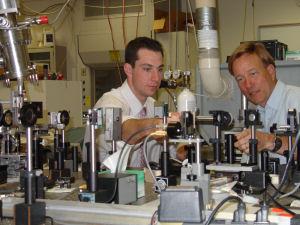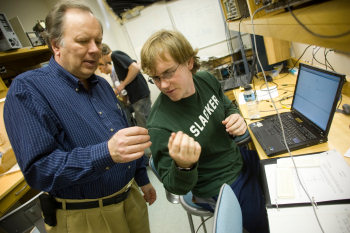Wake Forest Physics…
Nationally recognized for teaching excellence;
internationally respected for research advances;
a focused emphasis on interdisciplinary study and close student-faculty collaboration; committed
to a diverse and inclusive environment.
Condensed Matter Physics
The area of major concentration is condensed matter physics, which includes the work of experimentalists, David Carroll, Oana Jurchescu, and Richard T. Williams, and theorists Natalie A. W. Holzwarth, William C. Kerr, G. Eric Matthews, and Timo Thonhauser.
 The
group working with Richard Williams uses ultrafast spectroscopy to investigate the immediate consequences of absorption
of a photon by a crystalline solid. They use ultrashort (~80 fs) laser pulses
to create an electronic excitation of the solid and monitor its evolution
within the coupled electron-lattice system. Phenomena of interest include
self-trapping of excitons and of charge carriers in insulators, relaxation
of hot carriers and surface state dynamics in semiconductors, excitonic processes
of lattice defect formation, and desorption from surfaces. Photoelectron spectroscopy
and related surface science techniques are conducted both with ultrafast excitation/probe
laser techniques for dynamic studies and in conventional synchrotron radiation
experiments at the National Synchrotron Light Source.
The
group working with Richard Williams uses ultrafast spectroscopy to investigate the immediate consequences of absorption
of a photon by a crystalline solid. They use ultrashort (~80 fs) laser pulses
to create an electronic excitation of the solid and monitor its evolution
within the coupled electron-lattice system. Phenomena of interest include
self-trapping of excitons and of charge carriers in insulators, relaxation
of hot carriers and surface state dynamics in semiconductors, excitonic processes
of lattice defect formation, and desorption from surfaces. Photoelectron spectroscopy
and related surface science techniques are conducted both with ultrafast excitation/probe
laser techniques for dynamic studies and in conventional synchrotron radiation
experiments at the National Synchrotron Light Source.
 Concerns with surfaces, lattice defects, and laser-solid interactions lead
naturally to a parallel interest in the spatial atomic structure of surfaces
and surface defects, observed directly by scanning tunneling microscopy and
atomic force microscopy. The scanning tunneling microscope is used to characterize
laser effects on metals and semiconductors, as well as more general atomic-scale
studies.
Concerns with surfaces, lattice defects, and laser-solid interactions lead
naturally to a parallel interest in the spatial atomic structure of surfaces
and surface defects, observed directly by scanning tunneling microscopy and
atomic force microscopy. The scanning tunneling microscope is used to characterize
laser effects on metals and semiconductors, as well as more general atomic-scale
studies.
While
the focus is basic research, the department is extensively involved in laser
processing of materials. Richard Williams, Eric
Matthews, and their students have produced and characterized
thin film high-Tc superconductors of good quality. Applied research in laser
planarization and bonding of metals and in photoablation of polymers is conducted
by the Williams group. ![]()
Oana Jurchescu’s group focuses on investigation and development of organic materials and devices for nano and macroelectronics applications. The group is part of the Center for Nanotechnology and Molecular Materials, one of the Research Institutes at Wake Forest University.
The research in Organic Electronics group covers a variety of fundamental and applied topics on materials and devices for future electronics. The interest in this topic is motivated by the potential of organic (plastic) electronics to greatly impact the future semiconductor industry by low-cost and high diversity.  Our efforts aim to improve the performance of organic electronic devices by better understanding and control of charge injection and transport, charge trapping and de-trapping. One critical issue in organic electronics is that the device performance is dominated by the micro- and nano-scale structure features of the organic film, which in turn is dictated by the chemical structure and processing. The structure, processing and performance are thus strongly influenced by each other. Our studies focus on describing the structure-processing-property relationship that governs the physical processes in organic semiconductors. The results will be providing the frame for comparisons between novel organic semiconducting molecules and will promote the discovery of materials with enhanced electronic properties. We are also interested Organic spintronics, and are working on this project in collaboration with National Institute of Standards and Technology.
Our efforts aim to improve the performance of organic electronic devices by better understanding and control of charge injection and transport, charge trapping and de-trapping. One critical issue in organic electronics is that the device performance is dominated by the micro- and nano-scale structure features of the organic film, which in turn is dictated by the chemical structure and processing. The structure, processing and performance are thus strongly influenced by each other. Our studies focus on describing the structure-processing-property relationship that governs the physical processes in organic semiconductors. The results will be providing the frame for comparisons between novel organic semiconducting molecules and will promote the discovery of materials with enhanced electronic properties. We are also interested Organic spintronics, and are working on this project in collaboration with National Institute of Standards and Technology.
The Organic electronics program consists of exciting and interdisciplinary topics of research, providing opportunities for both undergraduate and graduate involvement. For more info please visit: http://www.wfu.edu/~jurcheod/research/![]()
William Kerr leads a group in the study of statistical physics. The research in this group concentrates on systems in which nonlinearity is the dominating feature. In some situations nonlinearity produces highly organized behavior, which is described by solitons. In other cases nonlinearity produces seemingly random behavior, which is often characterized as chaos. This group studies these phenomena by computer simulations. Their emphasis recently has been on studying soliton mechanisms underlying the dynamics of first- and second-order phase transitions. The experimental impetus for these studies comes from structural phase transitions in solids. The major issues here include the existence or nonexistence of soft modes and of precursor fluctuations of the product phase occurring within the parent phase. Such fluctuations would be described by nonlinear partial differential equations similar to the sine-Gordon or nonlinear Schrodinger equations, perhaps with extensions which describe bond anharmonicity in addition to the site anharmonicity. In addition to these important physical questions, employing computer simulation to study these problems raises a set of methodological problems. These deal with writing computer codes that efficiently use vector supercomputer architectures and with developing methods of analysis, including visualization schemes, that effectively extract the important physical processes occurring in the system from the large volume of numbers produced by the simulations .
Natalie Holzwarth, Rick Matthews, and Timo Thonhauser lead research groups that conduct first principles computer modeling of electronic and structural properties of materials. They work closely with experimental groups on a variety of projects including the study of new materials, surfaces, and defects in crystals.
Most of the modeling is based on density functional theory, developed by Walter Kohn and his collaborators in 1964 (for which he shared the 1998 Nobel prize in Chemistry). The work is divided between a focus on code and algorithm development and a focus on materials physics.
The group has developed some general purpose electronic structure code which is made available on the web at http://pwpaw.wfu.edu.
Some of the recent materials studied by the group include scintillating crystals such as PbWO4, F-centers in alkali halide crystals, and surface states related to photoemission experiments performed in Richard Williams' lab. Other projects include studies of molecular crystals such the one illustrated in the figure and Li ion battery materials such as the cathode materials (FeLiPO4, FePO4) and electrolytes (Li3PO4).
 Ball and stick drawing of organic molecule (BEDT-TTF) with superposed
contours of electron density in indicated planes from calculations of P.
Tang and N. Holzwarth with experimental advice from J. Qualls.
Ball and stick drawing of organic molecule (BEDT-TTF) with superposed
contours of electron density in indicated planes from calculations of P.
Tang and N. Holzwarth with experimental advice from J. Qualls.
The group of Timo Thonhauser conducts research in theoretical and computational condensed-matter physics with a focus on the development of ab-initio electronic-structure methods and their application to bio-, nano-, and energy-related materials. These theoretical studies go hand-in-hand with experimental research and provide the necessary framework to understand the behavior and characteristics of materials. Such knowledge is the basis for the design of new, improved, and advanced materials with direct applications to all areas of technology.
The research in Thonhauser’s group usually has three components. The first component is model development, which in many cases is based on the theory of quantum mechanics. The next step is the translation of this theoretical model into a computer program, which involves the development of algorithms as well as the development of computer codes appropriate for parallel computing on super computers. The last step then is the application of theory and code to problems of current interest.
One project of current interest centers on the development of a new method for calculating ab-initio NMR chemical shifts, with a special emphasis on large systems such as bulk water, intercalated DNA, and proteins. Another project focuses on the calculation of the orbital magnetization in periodic crystals, in particular, simple metals like nickel, iron, and cobalt. Yet another project of current interest aims to extend density functional theory to include van der Waals interactions—which play an important part in many organic, biological, and nano materials—with applications ranging from hydrogen storage to DNA.
Page Links
David Carroll
Oana Jurchescu
Richard T. Williams
Natalie A. W. Holzwarth
William C. Kerr
G. Eric Matthews
Timo Thonhauser
100 Olin Physical Laboratory
Wake Forest University
Winston-Salem, NC 27109-7507
Phone: (336) 758-5337, FAX: (336) 758-6142
E-mail: wfuphys@wfu.edu

